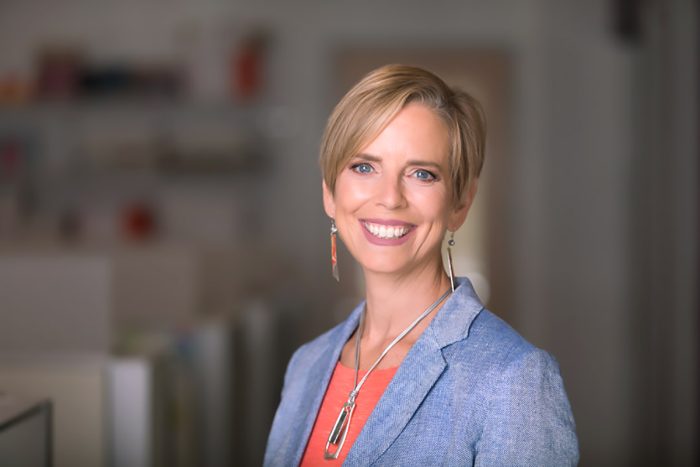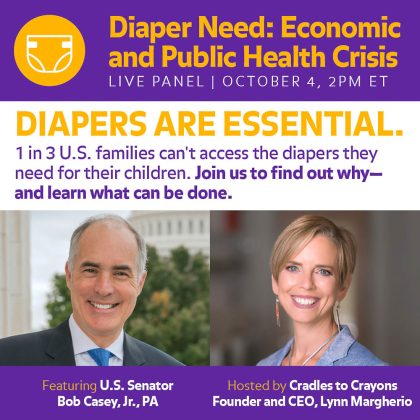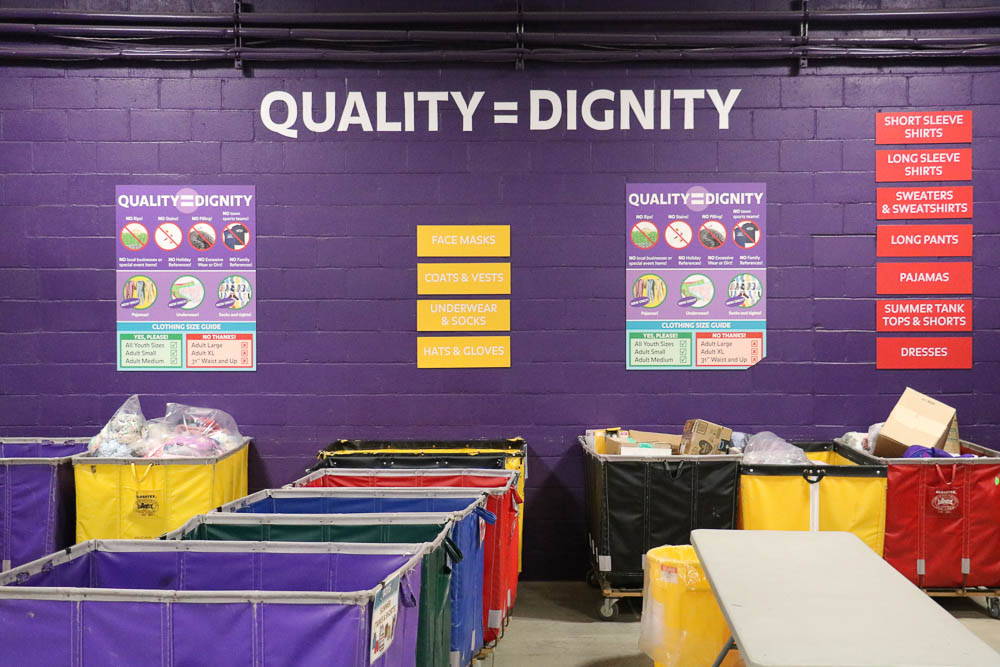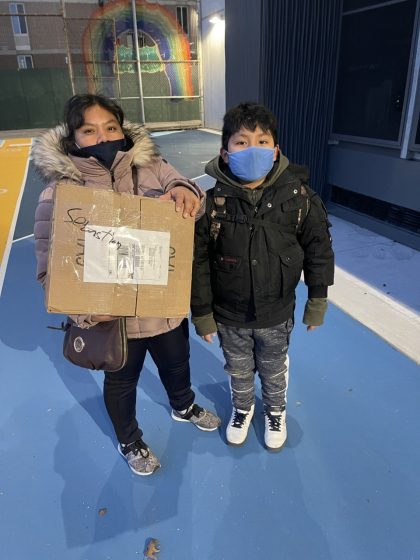In this month’s At the Helm, our Senior Vice President Suzanne Battit spoke with Lynn Margherio, Founder & CEO of Cradles to Crayons. Since 2002, Cradles to Crayons has been providing children from birth to age 12, living in low-income or homeless situations, with the essentials they need to thrive at school, at home, and at play. Here, Lynn discusses the challenges and opportunities in addressing an issue as great as Clothing Insecurity, reflects on 20 years of organizational growth from a small warehouse in Quincy, MA to locations nationwide, and shares her vision for what comes next.
Suzanne: How did Cradles to Crayons come to be?
 Lynn: It all started 20 years ago. I was visiting my family in Michigan—where I grew up—and was helping my niece Elise get dressed. As I looked through her drawers, I kept finding clothes that were brand new and still had tags on, but she had clearly outgrown them. And then, when I went over to my brother’s, who also had young children at the time, I noticed the same thing – there were so many new or like new items in his house that his kids had never used or weren’t using anymore.
Lynn: It all started 20 years ago. I was visiting my family in Michigan—where I grew up—and was helping my niece Elise get dressed. As I looked through her drawers, I kept finding clothes that were brand new and still had tags on, but she had clearly outgrown them. And then, when I went over to my brother’s, who also had young children at the time, I noticed the same thing – there were so many new or like new items in his house that his kids had never used or weren’t using anymore.
It really struck me, and that’s when I had the idea. Since kids grow so fast, there could potentially be an ever-recharging source of brand new or like new children’s clothes, books, and other supplies that could be moved from a house where they’re no longer needed into a home where they could meet critical resource gaps for another child.
I have a background in business strategy consulting so with that hat on, I decided to explore my idea and see if anyone else was already doing this, how they were doing it, and whether it was meeting a real need. I spoke with shelters, people at government programs, and social service case managers, and I heard the same thing over and over: “Yes, families are constantly asking us for help with clothing and other supplies for their children, and no, we do not have a good way to meet that need.” One of the biggest challenges was the amount of space and workers required to process the donations, sort them, and store them. So now knowing that there was a great need—and that no one was really addressing it in Massachusetts—I couldn’t shake the idea. I started cold calling schools and asking if they had parents who would want to make donations. What I heard back was really encouraging: they already had families who were interested in donating clothing and ensuring those donations got to children in need, but they had no means to do so. That’s the motivation I needed to pilot Cradles to Crayons. And now 20 years later, here we are, having served more than 4 million kids.
I think many people might be surprised to learn that two in five kids in the United States face Clothing Insecurity. Can you speak to the scale of this issue?
 It is pretty eye opening when you discover how large the issue is, especially since not many people are talking about it right now. It’s a hidden crisis. As you said, 2 in 5 children are at risk—which represents children living in families that are earning 200% of the poverty line or below. The recent data is alarming. This fall, nearly in 1 in 2 American households with children cannot afford their weekly expenses, which include clothing, hygiene supplies, and diapers. That’s an increase from the 40% of households that were struggling this past summer.
It is pretty eye opening when you discover how large the issue is, especially since not many people are talking about it right now. It’s a hidden crisis. As you said, 2 in 5 children are at risk—which represents children living in families that are earning 200% of the poverty line or below. The recent data is alarming. This fall, nearly in 1 in 2 American households with children cannot afford their weekly expenses, which include clothing, hygiene supplies, and diapers. That’s an increase from the 40% of households that were struggling this past summer.
Let me provide an example to help illustrate why this is happening. Consider a family of 4 in Philadelphia. If you have 2 parents working and receiving the median hourly wage, they make about $44,000 a year combined. That breaks down to about $3,650 a month. Now consider expenses: of course, they need a place to live, and $1,260 is the average rent for the area. Groceries are around $900 a month. And then transportation is another $1,100. If the children are too young to be in school, average childcare costs are $1,580 a month. So, if you’re following the math, that leaves the family overdrawn by $1,300 every month, and we haven’t even gotten to the basics like clothing or diapers. There is nothing in the budget for the items we provide at C2C.
Clearly, Clothing Insecurity is, unfortunately, a very widespread issue. Tell me more about how C2C is working to address it.
 We are focused on raising awareness of, advocating for, and alleviating the consequences of Clothing Insecurity for children in the geographies where we have Giving Factory warehouses—which are Massachusetts, Greater Philadelphia, and Chicagoland, as well as through our new online giving portal called Giving Factory Direct, which currently serves children in New York City and the Bay Area.
We are focused on raising awareness of, advocating for, and alleviating the consequences of Clothing Insecurity for children in the geographies where we have Giving Factory warehouses—which are Massachusetts, Greater Philadelphia, and Chicagoland, as well as through our new online giving portal called Giving Factory Direct, which currently serves children in New York City and the Bay Area.
Our first priority has to be raising awareness. If people don’t know there’s a need, then they don’t know they should or could be doing something about it. We have defined Clothing Insecurity as a lack of affordable and appropriate clothing that fits children. Now, we are working to really get that message out there and amplify it – both in the locations where we have these physical operations and nationally. We know that when people are aware of the need, they respond – that’s the good news. So, we see a lot of potential for people to engage directly with C2C and/or find opportunities to help on an individual, organizational, or corporate level.
 In terms of working directly with C2C, our Giving Factories offer volunteer opportunities for everyone from the age of 5 through 105. Our volunteers sort, inspect, and process clothing and other donations. People can also engage with us through our online platform from the convenience and comfort of their own home. So, for instance, you can let us know you have girls size 10 clothing to donate, and we can match you with a child who wears those clothes—and we give you a mailing label—so you can mail those clothes directly to them. Don’t have donations in your closet? Alternatively, you can go out and buy those outfits, or you can specifically shop for any child in any size. It’s a way to make a real difference for a child – either in your community or elsewhere in the U.S.
In terms of working directly with C2C, our Giving Factories offer volunteer opportunities for everyone from the age of 5 through 105. Our volunteers sort, inspect, and process clothing and other donations. People can also engage with us through our online platform from the convenience and comfort of their own home. So, for instance, you can let us know you have girls size 10 clothing to donate, and we can match you with a child who wears those clothes—and we give you a mailing label—so you can mail those clothes directly to them. Don’t have donations in your closet? Alternatively, you can go out and buy those outfits, or you can specifically shop for any child in any size. It’s a way to make a real difference for a child – either in your community or elsewhere in the U.S.
Lastly, there’s the advocacy piece. Right now, there are no federal or widespread state government programs to address clothing or diaper needs. It’s a gaping hole in the safety net, and we are working hard to put this need on the map for our policymakers at the state and federal levels.
What are the biggest challenges in doing this work? Did the pandemic create new challenges or opportunities?
The biggest challenge is the scale of the need – even with 20 years of work, I feel like we haven’t even scratched the surface of the problem. We know that no matter how fast we innovate or how big we grow, we cannot be the only solution. We need as many actors as possible to really make a difference.
During the pandemic, our business model was hit with a significantly hefty blow. Our work is founded on having lots and lots of people volunteering, working side by side in our warehouses. Overnight, we were told we couldn’t do that anymore. We had to completely rethink how we were going to do our work, and we had to really take the pulse of our community to understand what they needed in that moment.
 We learned that diapers were a huge need. You couldn’t even find diapers in a store most of the time. And when you did, they were extremely expensive because of the supply chain issues. So, our team pivoted and started distributing truckloads of diapers. We distributed 300% more, compared to before the pandemic. And that is a volume we’ve maintained—surpassed, at times—since March 2020. We also innovated and expanded our volunteer opportunities so our volunteers could sort and prepare items safely in their own homes. We went live with our online platform, Giving Factory Direct, which was certainly a learning curve. Now, we’re seeking to scale it to reach more children nationally.
We learned that diapers were a huge need. You couldn’t even find diapers in a store most of the time. And when you did, they were extremely expensive because of the supply chain issues. So, our team pivoted and started distributing truckloads of diapers. We distributed 300% more, compared to before the pandemic. And that is a volume we’ve maintained—surpassed, at times—since March 2020. We also innovated and expanded our volunteer opportunities so our volunteers could sort and prepare items safely in their own homes. We went live with our online platform, Giving Factory Direct, which was certainly a learning curve. Now, we’re seeking to scale it to reach more children nationally.
It’s incredible how you were able to pivot and now maintain that level of work today.
I completely credit our team. One of our core values is putting the kids first, and so while nothing about the pandemic was easy, it was always really clear what we needed to do. Our team proved to be very creative and incredibly resilient and resourceful. They created innovations, large and small, that met the needs of the time and the crisis, and now we’re in a place to decide which of these innovations we bring with us into our next phase.
Speaking of your core values, one of them is “Diversity is our strength, inclusivity our bond.” How does this inform your internal culture as well as organizational partners you choose?
DEI informs and is visible in everything we do – from our team to how we talk about our work to how we go about selecting our community partners.
At the start of the year, our entire OneC2C organization creates individual performance goals oriented towards DEI work. We have developed educational resources for our staff focused on cultural celebrations, holidays, and days of recognition. In 2021, we launched our first DEI Council, whose mission is to create an organizational culture and participatory environment that respects and values diverse backgrounds, experiences, and perspectives. The Council is made up of volunteers across our geographic markets and our national team and has created goals and priorities for the organization—and we are beginning to implement their recommendations. We are also focused on ensuring our recruitment and outreach strategies create more diverse teams across our organization, on our board, and with our volunteer leadership.
DEI-informed communications to our community and stakeholders are a priority for us, too. We have a huge sign in each of our Giving Factory locations—and it’s also prominent on our website—with the phrase “Quality = Dignity.”
 It’s about creating a mindset—internally and externally—that all kids should be treated with dignity and respect. When we are putting together packages for children and their families, every single article of clothing has been inspected for quality many times; there are no stains or pills, the clothes are in style, and they are something that you’d feel good about your own child receiving. We even look at what messages are on a shirt or in a book and ensure they are culturally appropriate and sensitive to a child’s home situation. We want the children and families to feel respected.
It’s about creating a mindset—internally and externally—that all kids should be treated with dignity and respect. When we are putting together packages for children and their families, every single article of clothing has been inspected for quality many times; there are no stains or pills, the clothes are in style, and they are something that you’d feel good about your own child receiving. We even look at what messages are on a shirt or in a book and ensure they are culturally appropriate and sensitive to a child’s home situation. We want the children and families to feel respected.
 And lastly, as we bring on and partner with different social service agencies and schools, we really consider it a reciprocal partnership. We survey them annually and collect feedback about the quality, timeliness, and appropriateness of the items we’re providing to them and the communities they are supporting. We ask what their community needs and how we should prioritize these needs. We also seek to share, in a dignified and appropriate way, some of the stories fromthe children and families that we’re serving, so that we are connecting our team and our Cradles to Crayons community to our shared mission in a very human and emotional way.
And lastly, as we bring on and partner with different social service agencies and schools, we really consider it a reciprocal partnership. We survey them annually and collect feedback about the quality, timeliness, and appropriateness of the items we’re providing to them and the communities they are supporting. We ask what their community needs and how we should prioritize these needs. We also seek to share, in a dignified and appropriate way, some of the stories fromthe children and families that we’re serving, so that we are connecting our team and our Cradles to Crayons community to our shared mission in a very human and emotional way.
Since your founding in Boston, Cradles to Crayons has expanded to greater Philadelphia, Chicago, and New York. Now you are actively recruiting two roles to expand your geographic reach – a Vice President of National Philanthropy and a Senior Director of Strategic and Philanthropic Partnerships, NYC. What vision do you have for the organization’s impact on a national scale?

Clothing Insecurity is a need that is still not on most people’s radars. We have learned a lot in 20 years, and this is one of the biggest lessons. One of our cultural values is “Lead the Way.” And we feel a responsibility and an opportunity to lead the way on building awareness across the country and spearheading a movement of families, schools, faith groups, corporations, and policymakers to address this crisis. Creating this kind of momentum and movement takes resources. So, these new roles are important additions to efforts that are getting off the ground right now.
We have already had a lot of success with getting people to take action in their own community, with building partnerships with individuals and corporations to donate goods, and with engaging other nonprofit agencies to help reach more children and meet their specific needs. We are also growing our connections with legislators, who are opening their eyes to this issue and taking notice. We are feeling very optimistic about our ability to make a difference – but it’s going to take work.
Since your founding, what moments/accomplishments have meant the most to you?
Early on, I had no idea what I was doing! All I had was an idea. I asked everyone in my network if they could help – my mom, siblings, aunts and uncles, colleagues, friends. They were all so supportive. I began to build the organization with just those personal connections, and I remember thinking, “This is going to take forever if all I have is my own network!” So, I’ll never forget walking into our first warehouse in Quincy on the day it all seemed like we were doing something bigger. It was only 4,000 square feet, but I didn’t know a single soul who was there. I looked around at all the volunteers and thought: How did you get here? Who are you? They had heard about this new organization called Cradles to Crayons in this tiny space in Quincy and had wanted to get involved. Word had spread. And now I was looking at a warehouse full of people who had no personal relation to me.
That was a really special moment for me. It gave me the encouragement to keep going – especially during those early days that involve a lot of pounding your head against the wall. I felt that there was this huge power in volunteerism – in people’s innate desire to help. That hadn’t even occurred to me when I first dreamed up this idea, to be honest. That moment made me realize that there’s something pretty powerful here, in our collective ability to make a change – and now I’m reminded of that every time I step into one of our Giving Factories. I am surrounded by people that I have no connection to other than this really powerful mission of ending Clothing Insecurity. I get to see people come in and give their most valuable asset – their time. I feel very grateful.

What advice would you share with fellow organizational founders/leaders?
It’s all about the people. They are the ones who power your mission. You have to be thoughtful about your recruiting strategies and seek out people who will be able to not only help the organization today but take you to where you see yourself in three to five years. And it’s about coming up with the systems, culture, and learning environment needed to retain those people and make them feel appreciated. Then extend that perspective to how you build your board, committees, and partnerships. Put yourself in the shoes of the individual or organization you are seeking to involve in your mission, and be thoughtful about how you keep them engaged, day after day. It’s what will get you through the tough times and the good times – and keep you united in your vision.

